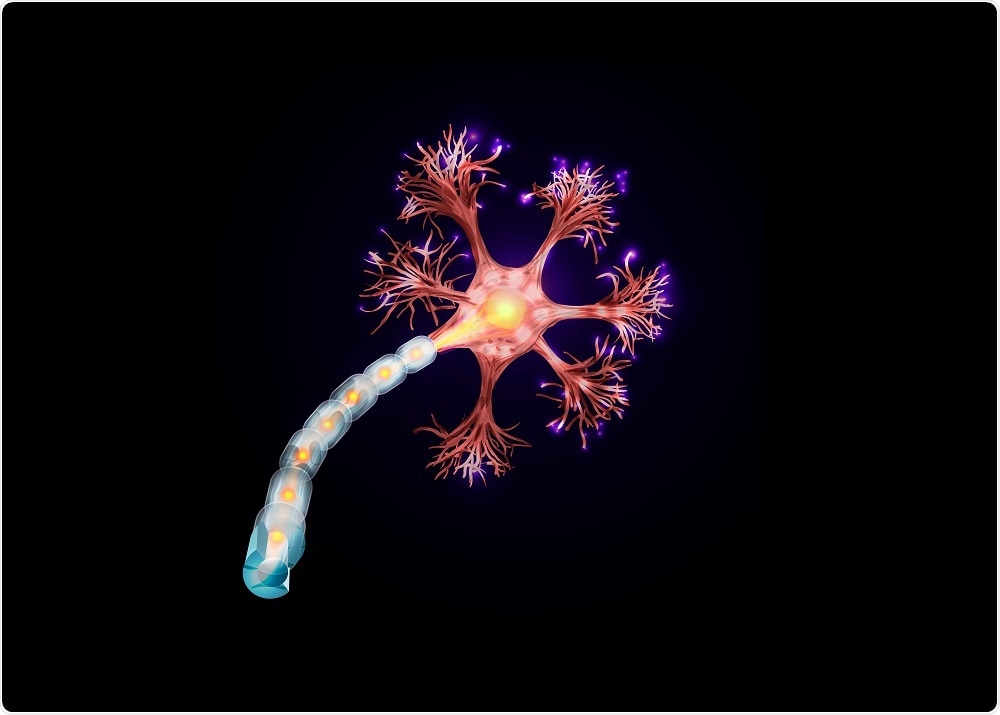A new study has uncovered mutations in 12 genes that may be responsible for the familial type of multiple sclerosis (MS), helping to better understand the mechanisms behind this devastating and incurable disease.
 Executioner | Shutterstock
Executioner | Shutterstock
MS is an illness of the brain and spinal cord, caused by an autoimmune attack of the protective fatty myelin sheath that encircles and insulates the nerve axons. Axons are the long nerve projections along which nerve impulses travel. The disease process results in inflammation around the nerves, leading to their breakdown and loss of function. It presents with initial weakness, and can significantly reduce the quality of life.
In the current study, the researchers traced 34 families with 3 or more members who had MS, for a total of 132 patients. They obtained samples of DNA from all family members and performed gene sequencing of all known MS genes, using a technique called whole exome sequencing (WES).
Finally, they looked at the gene differences between family members who had and did not have any signs of the disease. This allowed them to come up with the 12 mutations that, they think, promote abnormal immune function, leading to myelin disruption.
How do the mutations trigger MS?
The researchers found that these families showed a high MS incidence, with more than one-fourth of the siblings in each family having the condition. There were no marriages between first-degree relatives, ruling out consanguinity, and the disease was found in males and females equally. Parents were frequently unaffected.
These factors support their hypothesis that familial MS is caused by autosomal dominant mutations. This means that if one diseased copy of any of these genes is present, the individual is much more likely to develop the disease.
The mutations that they found affect multiple genes that express various components of innate immunity including inflammasomes, fibrinolysin, and complement components, as well as nuclear receptors that regulate gene expression in many body processes.
Inflammasomes are protein complexes located in the cytoplasm, which initiate the inflammatory cascade. Fibrinolysis and complement pathways consist of step-wise cascading enzymatic reactions that are interlinked at numerous levels by cellular signaling molecules. The complement cascade promotes an immune attack on targeted cells resulting in their breakdown.
Other mutations affect cation channels which regulate the ion concentrations within and outside the cells. Levels of ions like calcium, sodium, chloride, and potassium must be carefully balanced for cell health. Increased numbers of calcium and potassium channels have earlier been found in MS patients, and this triggers cell death with axonal breakdown.
Overall, the mutations observed in the 132 MS patients suggest that the familial form of MS is due to a their disruption of interlinked inflammatory and immune system pathways. This initiates the chronic inflammatory process that causes demyelination.
At the same time, not all members of the family who had these mutations developed the illness. Thus, the mutations create a genetic environment predisposing to the development of the condition, provided other specific genetic, epigenetic and environmental factors are present.
Why is it important to identify mutations in MS?
MS affects about 2 million people all over the world. Currently, scientists think that only about 13% of them have a genetic cause for the disease. Special genetic techniques like genome-wide association studies (GWAS) have uncovered over 200 genes which can increase the vulnerability to the condition. However, the new study shows that if any of the 12 newly discovered mutations are present, the individual has an 85% risk of developing MS over a lifetime.
The researchers intend to study how the mutations interfere with normal biological processes to cause MS, in cell cultures and in animal models. In addition, identifying these mutations could lead to the development of genetic screening tests to confirm the diagnosis and to assess the risk of developing it in unaffected members of the patient’s family.
More MS families need to be identified in order to understand better how the condition is triggered, so as to design effective preventive and treatment strategies.
We have treatments that address the symptoms of MS, but not the causes. People with MS take drugs that reduce the attacks, but the disease still progresses. Now, with knowledge of these mutations, which suggest a common biological process that leads to increased inflammation in MS families, we can try to address the root causes.”
Carles Vilariño-Güell, Lead Author
Journal reference
Vilarino-Guell C. et al., (2019). Exome sequencing in multiple sclerosis families identifies 12 candidate genes and nominates biological pathways for the genesis of disease. PLoS Genetics. doi.org/10.1371/journal.pgen.1008180